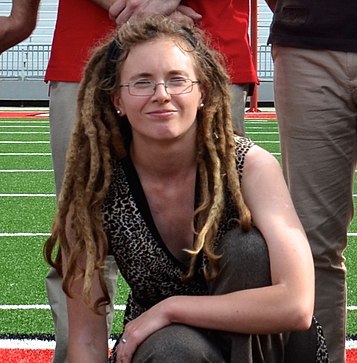
Image: File:Claire Jarvis Photo.jpg, Claire.jarvis42, CC BY-SA 4.0, via Wikimedia Commons.
Dr. Claire Jarvis is a Postdoctoral Scientist at Emory University with a PhD in organic chemistry. She recently participated in our professional development course that trains scholars, scientists, and other professionals how to edit Wikipedia. Here, she shares thoughts about her experience.
The oversight was egregious. I checked again in case a simple spelling error was concealing what I looked for. Nope. The female chemist I was searching for really was missing a Wikipedia entry.
My PhD and area of expertise is in synthetic organic chemistry. It’s not a niche field: a lot of chemists fall under that umbrella, or at least pass through organic chemistry classes during an education on their way somewhere else. The academic in question is well known. She is regularly invited to speak at prestigious conferences across the country and abroad – drawing large crowds at every talk. Her papers are disseminated and discussed in research group meetings – “beautiful” is how we usually describe her group’s latest discoveries. The only reason I can come up with for her lack of a Wikipedia page is because everyone assumed she already had one.
Not only are important female scientists missing Wikipedia pages (only 17% of Wikipedia’s biographies are for women) but the entries for these women are often incomplete. Out of 7,816 ‘Women Scientist’ pages, 5,860 of those are categorized as ‘stubs’ or ‘start’ articles – too short to give the reader much information about the person in question. The Women in Science Wikipedia Fellows course was designed to address both problems: not just creating new articles, but expanding and improving articles that already existed. Scientists were recruited via their professional organizations – I saw the call for participants on the American Chemical Society’s Twitter feed. Our cohort was predominantly made up of chemists, mathematicians, and statisticians – men and women. We were a mix of grad students, postdocs, staff scientists, and academics. We had the expertise to spot who were the big shakers in our respective fields, and who would be considered notable enough for a Wikipedia page. Armed with an understanding of what Wikipedia was looking for with their articles, I felt confident enough to write an article from scratch.
Pulling together the basic set of biographical facts was easy. I had access to their research group website, Google was quick to turn up interviews and references that I could mine. As a synthetic organic chemist I had a solid understanding of their research and its importance. I came up with a reasonable article that covered the basics: education, research, summary of notable awards. I submitted my draft through an approval process that many Wikipedia newcomers are funneled through. Wiki Education tends not to point people to this process, I learned later, since their materials guide newcomers through the typical obstacles that this particular process aims to curtail.
A few days later the draft was rejected. Feedback from the other Wikipedia editor was concise but polite – I hadn’t established “notability” in my entry. I admit I bit down on several sharp e-retorts to this editor: any synthetic organic chemist would describe this academic as “notable” – many would call her a “superstar”! But I’d just failed to convince this seasoned Wikipedia editor outside my field of her importance.
I went back to the draft. This is where Wikipedia’s guidelines help reinforce the gender disparity. Wikipedia has several criteria for academic notability: winner of national awards, holder of a named chair or distinguished professorship, leader of major academic institution or society, chief editor of a major journal. There are fewer women in general who have those prestigious CV lines. Your fellow academics know that the research output of a peer is important, but that doesn’t always translate into the concrete evidence Wikipedia requires for its articles.
If you want to prove that a scientist has made notable contributions to their scientific field, you need to cite secondary sources that discuss the research in question. While some fields of research consistently produce great newspaper stories – new cancer treatments, solving energy problems – synthetic organic chemistry discoveries are rarely picked up by the national media. I knew this article was worth pursuing, I just needed more secondary sources. I returned to Google and upped my creativity. Reliable secondary sources for research include news reports in our trade magazine, journal highlights, and every award announcement I could find. I combed through my article draft, hitting the ‘Cite’ button as often as I could. I almost doubled the number of references.
Second time around was the charm. The Wikipedia Fellows’ instructors gave me additional guidance for publishing my page without it getting trapped in an approval process with several months’ of backlog. Now my article can be seen and edited by everyone. The process of creating content on Wikipedia can be frustrating – especially when you face a rejection – but there’s incredible satisfaction to be found when scouting online for nuggets of secondary information that strengthens a stub article.
To read more reflections by participants in our professional development courses, click here. If you’d like to get involved, reach out to contact@wikiedu.org.

Thanks for noting the absence of an entry for this important chemist, and thanks for your persistence in getting it published in Wikipedia.